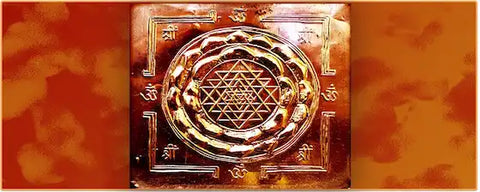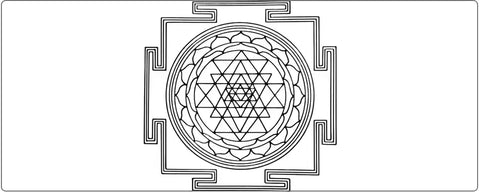Sri Yantra: Origin and Uses

Don't know what a Sri Yantra is? Having trouble understanding the meaning of this diagram? Don't worry, we'll tell you everything you need to know! You won't be able to meditate without it!
What is the Sri Yantra?

In Buddhism and Hinduism, a Yantra is simply a diagram with various geometric shapes. It's a drawing that allows the viewer to focus on a single element. It's meant to help the person perceive intuitive insights.
It's also important not to confuse a yantra with a mandala. Although they are related, they are quite different. A yantra is a design made with very geometric shapes. A mandala, on the other hand, is made with more elaborate forms and therefore requires a great deal of concentration.
It is also important to note that a yantra, in the Hindu religion, represents divine and cosmic forms.
What are the origins of the Sri Yantra?

But to learn more about this symbol we've introduced, we invite you to stay with us. The yantra is simply a symbol that represents the connection between humanity and metaphysics. In Buddhist and Hindu religions, it finds its origins in the creation of various concepts and aspects of the world. Currently, there are at least 960 yantras, but the most well-known remains the Sri Yantra. Furthermore, it's important to note that the Sri Yantra is considered the original yantra, as it encompasses all existing representations of the yantra.
Note that it can also be used in meditation . Indeed, it is a sacred element highly valued for its ability to aid concentration, as we will see later. For your information, you may find the Sri Yantra referred to as the Sri Chakra in various texts.
What does the sacred geometry of the Sri Yantra correspond to?

The first thing you might notice is the nine interlocking triangles, which symbolize masculinity (five downward-pointing triangles) and femininity (four upward-pointing triangles). They also evoke the concept of balance in the universe, which could be linked to the Chinese philosophical concepts of yin and yang. The round dot in the center of the design is the "bindu," which is said to represent the origin of creation and the relationship between the Hindu god Shiva and Shakti.
The outer edge of the symbol is surrounded by four "gates." These represent the distinct nature of the material world, something many of us like to focus on. From there, we enter the circle, which shows the cyclical nature of life, and the two layers of lotus petals, which represent the fertile life force of creation. As some may know, the lotus flower is a very important symbol because it is a flower that grows in mud. It is linked to the process of human growth and, ultimately, to blossoming and opening up to enlightenment.
The interlocking triangles of this sacred symbol represent the relationship between femininity and masculinity, and the complexity of consciousness (since the nine interlocking triangles create 43 other triangles). Finally, the central point is where everything begins, the starting point of life and creation.
What are the benefits of the Sri Yantra?

The Sri Yantra has many benefits. But to help you easily find what you're looking for, here's a short essential list:
- It's an excellent meditation tool, as we discussed in the previous section. It truly allows a person to rediscover their identity.
- It also allows the person to concentrate optimally. Indeed, the Sri Yantra is simply an object that allows for intensive concentration.
- By meditating with this tool, you can easily reconnect with your primordial sources. Indeed, it symbolizes, among other things, the creation of the universe.
Of course, the Sri Yantra is very popular among Buddhists and Hindus. However, it's important that you can easily use it during your meditations. Note that Sri Yantra pendants can help you stay immersed and focused throughout the day!

About the author: Elara Vey
Passionate about ancestral traditions and well-being practices, Elara shares her discoveries for Kaosix to help you integrate more harmony and meaning into your daily life.
Discover her journey →
